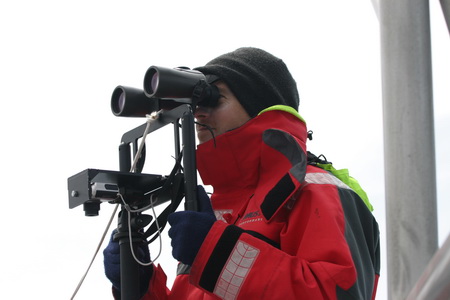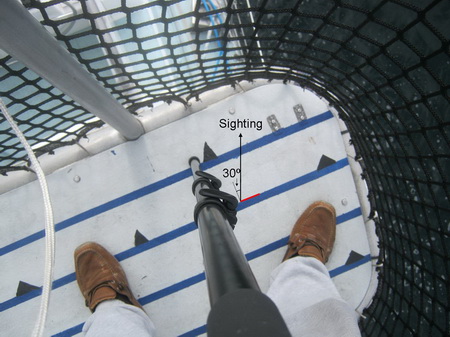The first leg of the harbour porpoise survey finished at the end of May, and Song of the Whale docked in Cherbourg for a crew change on 31st May. Our first few days of survey were a mixed bag of weather, shipping and sightings:
As we left Ipswich for our first transect across the Channel we were lucky to have perfect sightings conditions – sunshine and calm seas. However, rather than cetacean calls, the hydrophone was filled with ship noise from the busy shipping lanes. The noise emitted by the large tankers and even small fishing vessels, even at a distance of several miles, was clearly distinguishable and, at times, deafening.
We are getting to grips with our new sightings protocol, aimed at calculating distance to sightings (using reticules and compasses in our binoculars and taking photos of the sighting angle from the position of our feet), but unfortunately no sightings of any marine mammals today. As the night drew in we receive reports of worsening weather so decide to shelter in Eastbourne for the next day.
Heading out again after a smooth night’s sleep, the worst of the weather was over but the winds were still high and sea state wild for the next few days, reducing our chances of sighting porpoises. The acoustic survey continues as we pass through the last of the shipping channels.
As the weather starts to improve the conditions became perfect for sailing with moderate winds and dying swell. For as much time as possible, the team brave the A-frame to try to get sightings of the elusive harbour porpoises; unfortunately we only log one visual detection as the weather is still not ideal — we are almost completely reliant on the acoustic detection systems. Harbour porpoises make very high frequency clicks which are not detectable to human hearing, so we run automatic-detectors on the acoustic data to pick up the harbour porpoise vocalisations
. And to complicate matters further, because their clicks are such high frequency, they can only be detected acoustically at close range (around 250 – 400 metres) dependent on other conditions; it really feels like we are searching for a needle in a rather large haystack.
On the last survey day of the first leg, we have glassy calm seas and sunshine near the French coast and our sightings of harbour porpoises increase. Four fleeting sightings of harbour porpoises occur, one of which was of a possible mother and calf pair which lifted the spirit of the team no end. Although the wind picks up for our night time crossing of the Channel towards Cherbourg in France, the eastern leg of our survey has been successful in confirming the presence of harbour porpoises visually. Hopefully conditions will improve as we head west on leg two of the survey.


Sorry, comments are closed for this post.